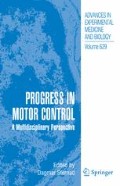Abstract
Neuromuscular function is the interaction between the nervous system and the physical world. Limbs and fingers are, therefore, the ultimate mechanical filters between the motor commands that the nervous system issues and the physical actions that result. In this chapter we present a mathematical approach to understanding how their anatomy (i.e., physical structure) defines their mechanical capabilities. We call them “mechanical filters” because they attenuate, amplify, and transform neural signals into mechanical output. We explicitly distinguish between limbs and fingers because their subtle anatomical differences have profound effects on their mechanical properties. Our main message is that many aspects of neuromuscular function such as co-contraction, posture selection, muscle redundancy, optimality of motor command, are fundamentally affected (if not defined) by the physical structure of limbs and fingers. We attempt to present the fundamental filtering properties of limbs and fingers in a unified manner to allow for a direct and useful application of powerful mathematical concepts to the study of neuromuscular function. Every researcher of motor control is well advised to consider these filtering properties to properly understand the co-evolution and synergistic interactions between brain and body. At the end of the day, every inquiry in neuromuscular function can be reduced to the fundamental question whether and how the nervous system can perform the necessary sensorimotor functions to exploit and reach the mechanical capabilities of limbs and fingers.
Access this chapter
Tax calculation will be finalised at checkout
Purchases are for personal use only
Notes
- 1.
This is because a convex sets remains convex under linear mapping. Thus, if the musculature can produce net joint torques in every quadrant of the torque space, i.e., if its feasible torque set includes the origin, then the endpoint of the limb will also be able to produce wrenches (forces and torques) in every quadrant of the output wrench space. Its feasible wrench set will include the origin.
References
Avis D, Fukuda K (1992) A pivoting algorithm for convex hulls and vertex enumeration of arrangements and polyhedra. Discrete and Computational Geometry:295–313.
Bobbert MF, van Ingen Schenau GJ (1988) Coordination in vertical jumping. J Biomech 21:249–262.
Brand P, Hollister A (1999) Clinical mechanics of the hand, 3rd Edition. St. Louis: Mosby-Year Book, Inc.
Chvátal V (1983) Linear programming. New York: W.H. Freeman and Company.
d'Avella A, Bizzi E (2005) Shared and specific muscle synergies in natural motor behaviors. Proc Natl Acad Sci U S A 102:3076–3081.
Dewald JP, Pope PS, Given JD, Buchanan TS, Rymer WZ (1995) Abnormal muscle coactivation patterns during isometric torque generation at the elbow and shoulder in hemiparetic subjects. Brain 118 (Pt 2):495–510.
Hogan N (1985) The mechanics of multi-joint posture and movement control. Biol Cybern 52:315–331.
Kuo AD, Zajac FE (1993) A biomechanical analysis of muscle strength as a limiting factor in standing posture. J Biomech 26(Suppl 1):137–150.
Kuxhaus L, Roach SS, Valero-Cuevas FJ (2005) Quantifying deficits in the 3D force capabilities of a digit caused by selective paralysis: application to the thumb with simulated low ulnar nerve palsy. J Biomech 38:725–736.
Leijnse JN (1996) A graphic analysis of the biomechanics of the massless bi-articular chain. application to the proximal bi-articular chain of the human finger. J Biomech 29:355–366.
Loeb GE (2000) Overcomplete musculature or underspecified tasks? Motor Control 4:81–83; discussion 97–116.
Mayston MJ (2001) People with cerebral palsy: effects of and perspectives for therapy. Neural Plast 8:51–69.
Obholzer A (1954) Chain-synergies in neuromuscular re-education; in the infantile cerebral flaccid-spastic syndrome. S Afr Med J 28:105–110.
Pearlman JL, Roach SS, Valero-Cuevas FJ (2004) The fundamental thumb-tip force vectors produced by the muscles of the thumb. J Orthop Res 22:306–312.
Spoor CW (1983) Balancing a force on the fingertip of a two dimensional finger model without intrinsic muscles. J Biomech 16:497–504.
Tresch MC, Cheung VC, d'Avella A (2006) Matrix factorization algorithms for the identification of muscle synergies: evaluation on simulated and experimental data sets. J Neurophysiol 95(4):2199–2212.
Valero-Cuevas FJ (2000) Predictive modulation of muscle coordination pattern magnitude scales fingertip force magnitude over the voluntary range. J Neurophysiol 83:1469–1479.
Valero-Cuevas FJ (2005) An integrative approach to the biomechanical function and neuromuscular control of the fingers. J Biomech 38:673–684.
Valero-Cuevas FJ, Hentz VR (2002) Releasing the A3 pulley and leaving flexor superficialis intact increase palmar force following the Zancolli lasso procedures to prevent claw deformity in the intrinsic minus hand. J Orthop Res 20:902–909.
Valero-Cuevas FJ, Zajac FE, Burgar CG (1998) Large index-fingertip forces are produced by subject-independent patterns of muscle excitation. J Biomech 31:693–703.
Valero-Cuevas FJ, Towles JD, Hentz VR (2000) Quantification of fingertip force reduction in the forefinger following simulated paralysis of extensor and intrinsic muscles. J Biomech 33:1601–1609.
van Ingen Schenau GJ, Bobbert MF (1993) The global design of the hindlimb in quadrupeds. Acta Anat (Basel) 146:103–108.
van Soest AJ, Schwab AL, Bobbert MF, van Ingen Schenau GJ (1993) The influence of the biarticularity of the gastrocnemius muscle on vertical-jumping achievement. J Biomech 26:1–8.
Welmer AK, Holmqvist LW, Sommerfeld DK (2006) Hemiplegic limb synergies in stroke patients. Am J Phys Med Rehabil 85:112–119.
Winter DA (1990) Biomechanics and motor control of human movement, 2nd Edition. New York: Wiley.
Yoshikawa T (1990) Foundations of robotics: analysis and control. Cambridge: The MIT Press.
Author information
Authors and Affiliations
Corresponding author
Editor information
Editors and Affiliations
Rights and permissions
Copyright information
© 2009 Springer Science+Business Media, LLC
About this chapter
Cite this chapter
Valero-Cuevas, F.J. (2009). A Mathematical Approach to the Mechanical Capabilities of Limbs and Fingers. In: Sternad, D. (eds) Progress in Motor Control. Advances in Experimental Medicine and Biology, vol 629. Springer, Boston, MA. https://doi.org/10.1007/978-0-387-77064-2_33
Download citation
DOI: https://doi.org/10.1007/978-0-387-77064-2_33
Publisher Name: Springer, Boston, MA
Print ISBN: 978-0-387-77063-5
Online ISBN: 978-0-387-77064-2
eBook Packages: Biomedical and Life SciencesBiomedical and Life Sciences (R0)

